Introducing BSCS’s New Flagship High School Biology Program
Teachers are being asked to do a lot in today’s science classrooms. That includes teaching the Next Generation Science Standards, which are challenging in both depth and breadth. BSCS has responded to this need by creating a brand new high school biology program that supports teachers in meeting these standards. But we didn’t stop there.
Our new program, BSCS Biology: Understanding for Life, has a greater purpose. It is designed to prepare high school students for life in our complex, interconnected world.
The program includes four units, each centered around a 21st century societal challenge that we can no longer ignore, such as antibiotic-resistant infections. Students are challenged to investigate. They “figure out” rather than “learn about” scientific phenomena. This approach is different. It requires a different kind of work. And the unfamiliar can be frustrating, at first—especially for students who have learned to play the game of school by memorizing facts to get an A.
However, as we’ve seen through field testing and initial program adoption in 2020-2021, this approach is powerful. And teachers believe this program is going to change the way students learn and use science throughout their lives.
Key Program Features
- Introduces BSCS’s new Anchored Inquiry Learning instructional model, which builds on the strengths of our globally recognized 5E model, while drawing on contemporary research about the social, cultural, and emotional aspects of the learning process
- Designed from the ground up to support teachers in meeting the Next Generation Science Standards
- Specifically integrates supports for English language learners and students with below-grade-level literacy skills
- Directly addresses societal challenges we can no longer ignore, while allowing students to investigate compelling and relevant phenomena that will keep them from ever asking, “Why do I need to know this?”
- Equips students with abilities and inclinations to act on what they’ve learned well beyond high school biology class and into their future personal, professional, and civic lives
Inside the Units
BSCS Biology: Understanding for Life includes four units, each centered around a societal challenge. High school students investigate an anchoring phenomenon while developing the knowledge, abilities, and inclinations to take positive action on behalf of themselves, their communities, and the natural world.
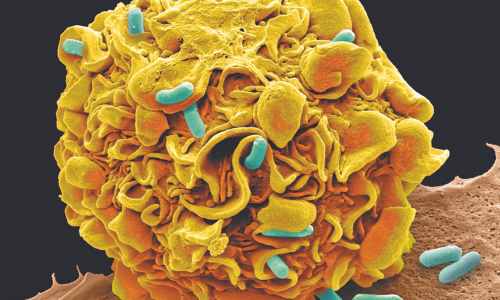
Unit 1: Infectious Diseases
How can bacterial infections make us sick, and why are they getting harder to treat?
Key Concepts
- Body systems & specialized cells
- Homeostasis & feedback
- Natural selection
Unit 2: Hereditary-Genetic Disease
Why are some people at higher risk for heart disease than other people?
Key Concepts
- DNA structure determines protein structure
- Meiosis & crossing over
- Mitosis & differentiation
- Environmental influence on traits


Unit 3: Matter and Energy
How can we sustainably feed our growing population a nutritious diet?
Key Concepts
- Photosynthesis & cellular respiration
- Matter & energy flow
- Trophic levels
- Carbon cycle
Unit 4: Biodiversity and Humans
Why are coyotes expanding their range while so many other organisms are becoming endangered?
Key Concepts
- Ecosystem interactions & carrying capacity
- Disturbance & anthropogenic change
- Speciation, extinction, & evolution
- Biodiversity & ecosystem services

Toolkit for Teachers
Learn more about this new high school biology program on Kendall Hunt Publishing Company’s website.
The OpenSciEd initiative was launched to address a critical need in science education: the need for high quality science instructional materials that are standards-aligned and practical for broad implementation. Led by BSCS Science Learning, a national consortium of curriculum developers and researchers created a three-year middle school science program for free distribution.
The program’s classroom materials and associated teacher professional learning materials are
- designed to align with the NRC Framework for K-12 Science Education and the Next Generation Science Standards (NGSS),
- based on research on student learning and teacher practice,
- developed in collaboration with teachers and field-tested in hundreds of classrooms in ten states across the United States,
- open-source and locally adaptable, and
- continuously improved based on feedback from teachers and field testing.
The complete, three-year middle grades science program is now available for free download at OpenSciEd.
Learn more about select units below.
Weather, Climate & Water Cycling
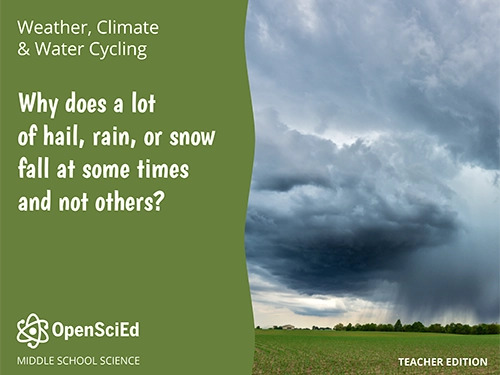
This 6th grade unit on weather, climate, and water cycling is broken into four separate lesson sets. In the first two lesson sets, students explain small-scale storms. In the third and fourth lesson sets, students explain mesoscale weather systems and climate-level patterns of precipitation. Each of these two parts of the unit is grounded in a different anchoring phenomenon.
The unit starts out with anchoring students in the exploration of a series of videos of hailstorms from different locations across the country at different times of the year. The videos show that pieces of ice of different sizes (some very large) are falling out of the sky, sometimes accompanied by rain and wind gusts, all on days when the temperature of the air outside remained above freezing for the entire day. These cases spark questions and ideas for investigations, such as investigating how ice can be falling from the sky on a warm day, how clouds form, why some clouds produce storms with large amounts of precipitation and others don’t, and how all that water gets into the air in the first place.
The second half of the unit is anchored in the exploration of a weather report of a winter storm that affected large portions of the midwestern United States. The maps, transcripts, and video that students analyze show them that the storm was forecasted to produce large amounts of snow and ice accumulation in large portions of the northeastern part of the country within the next day. This case sparks questions and ideas for investigations around trying to figure out what could be causing such a large-scale storm and why it would end up affecting a different part of the country a day later.
Matter Cycling & Photosynthesis
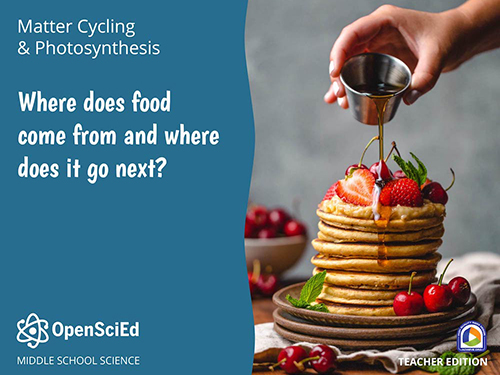
This 7th grade unit on matter cycling and photosynthesis begins with students reflecting on what they ate for breakfast. Questions about where their food comes from lead them to consider which breakfast items might be from plants. Then students explore (and taste) a common breakfast food, maple syrup, and see that according to the label, it is 100% from a tree.
Students apply what they learned in a previous unit to argue that they know what happens to sugar in syrup or other foods when they consume it. Students explore what else is in food and discover that foods from plants not only have sugars but proteins and fats as well. This discovery leads them to wonder how plants are getting these food molecules, why a plant needs food, and where a plant’s food comes from in the first place. Students figure out that they can trace all food back to plants, including processed and synthetic food. They explain that the pieces of their food are constantly recycled between living and nonliving parts of a system.
Forces at a Distance

This 8th grade unit launches with a slow motion video of a speaker vibrating. Students explore the cause of a speaker’s vibration as opposed to the effect.
Students dissect speakers to explore what’s inside, and they build homemade cup speakers. They identify that speakers of all kinds have some of the same parts—a magnet, a coil of wire, and a membrane. Students investigate each of these parts to figure out how they work together in the speaker system. Along the way, students manipulate the parts to see how this technology could be modified to apply to systems in very different contexts, like MagLev trains, junkyard magnets, and electric motors.
Thermal Energy
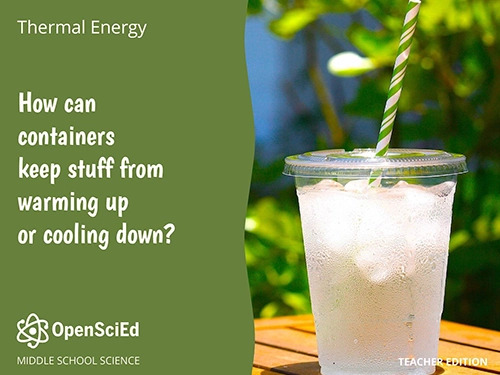
This unit on thermal energy engages students in a design challenge to create a cup that keeps drinks cold longer. They identify the features that make some cups better at keeping drinks cold, and they construct their own models to explain how those features prevent the transfer of thermal energy.
In this unit for 6th grade, students build an understanding of energy transfer within and between materials based on a particle model, and they work on the practices of modeling, conducting investigations, constructing explanations, arguing from evidence, and designing solutions.
Metabolic Reactions

This unit on metabolic reactions in the human body engages students in an investigation of a real case study of M’Kenna, a 13-year-old girl, who reported some alarming medical symptoms to her doctor. Her case sparks questions and ideas for investigations to figure out which parts of M’Kenna’s body are functioning differently from a healthy person’s system and why. Through the work of investigating M’Kenna’s symptoms, the class constructs a model to explain what happens to food after it enters people’s bodies, and they use it to explain M’Kenna’s symptoms.
In this 7th grade unit, students build an understanding of how body systems interact to process food and use the energy stored within it. They work on the practices of developing models, interpreting data, and arguing from evidence.
Sound Waves
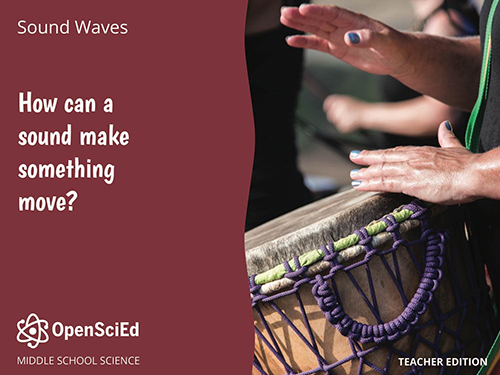
In this unit, students investigate how sounds can cause objects at a distance to move. Motivated by a video of windows shaking when a truck outside plays loud music, students investigate what happens when an object makes sound. Over the course of the unit, they build a model that describes what happens when sounds are created that can explain the shaking windows and other examples of sounds causing objects to move.
In this 8th grade unit, students use a particle model of air to build an understanding of how sounds move that explains the effect of sounds on other objects. They work on the practices of planning and conducting investigations, using mathematical and computational thinking, and evidence-based argumentation.
The consortium of curriculum developers includes BSCS, Boston College, the Dana Center at The University of Texas at Austin, Digital Promise Global, Northwestern University, and a broad network of leaders in science education. This developers consortium works in close collaboration with a state steering committee representing ten partner states from across the United States.
OpenSciEd is funded by the Carnegie Corporation of New York, Bill and Melinda Gates Foundation, Charles and Lynn Schusterman Family Foundation, and the William and Flora Hewlett Foundation.
Why is citizen science important? Not only does it allow communities to play a role in advancing scientific knowledge, it empowers individuals of all ages to make meaningful observations and learn about their natural environments. BSCS Science Learning’s interactive platform called FieldScope is transforming the way educators, community members, and organizations engage in citizen science.
With FieldScope, teachers and students can participate in a variety of projects ranging from supporting amphibian conservation by reporting on calls of local frogs and toads to monitoring plants in their own school gardens. Participants conveniently upload to a shared project database the measurements, observations, and media they gather outdoors. Project organizers and community participants can then leverage sophisticated graphing and mapping visualization tools to gain broader perspectives on the environment.
FieldScope is freely available to educators, students, and community members who wish to participate in existing projects or launch new ones.
This resource is funded in part by Gordon and Betty Moore Foundation.

This material is based upon work supported by the National Science Foundation under Grant No. DRL-1503005. Any opinions, findings, and conclusions or recommendations expressed in this material are those of the author(s) and do not necessarily reflect the views of the National Science Foundation.
Middle school educators across the US are expected to dive into next generation science. However, high quality NGSS-aligned materials and professional learning opportunities are scarce. That’s why BSCS’s 3-D middle school science program—A Medical Mystery—is valuable. It supports teachers in the effective instruction of an NGSS-aligned, EQuIP-reviewed body systems curriculum unit.
Students using this program are immersed in an online environment that challenges them to solve the medical mystery: “What’s Wrong with M’Kenna?” Over the course of several lessons, students investigate how and why M’Kenna is constantly sick, unable to keep her food down, and losing weight. They use scientific reasoning skills and argumentation to identify the digestive system as the problematic organ system—and then engage with a series of interactive experiences, simulations, and animations to observe and analyze the differences between M’Kenna’s digestive system and a healthy person’s digestive system.
Ultimately, students solve the mystery and explain all of M’Kenna’s symptoms based on how body systems interact. More importantly, they learn to use the inquiry-based practices of scientists and crosscutting concepts of systems and system models to construct their own understanding of complex phenomena.
This resource includes the complete middle school science curriculum unit and a teacher’s guide. The curriculum received a badge from the EQuIP review, indicating it is an example of high quality NGSS instruction.
Planning for online instruction? This document will help you quickly adapt A Medical Mystery for your new online classroom setting.
NGSS Design Badge
Awarded: Jan 4, 2022
Awarded To: A Medical Mystery
This resource was developed in partnership with OPB.

This material is based upon work supported by the National Science Foundation under Grant No. (DRL-1502571). Any opinions, findings, and conclusions or recommendations expressed in this material are those of the author(s) and do not necessarily reflect the views of the National Science Foundation.
Educators in central O’ahu want to immerse students in traditional and next generation science learning in a way that deepens their connection to the place of Hawaiʻi. With this goal in mind, the Leilehua-Mililani-Waialua Complex partnered with BSCS Science Learning to co-design and field-test a new curriculum unit for middle school students.
The resulting science unit, Restoring Ea, is place-based, three-dimensional, and phenomenon-focused. While specifically designed for seventh grade teachers and students in central O’ahu, Restoring Ea could be adapted and used by middle school teachers across the country who are looking to engage their students in meaningful, next generation science learning.
The Restoring Ea unit includes classroom materials and associated professional learning resources. It is now freely available.
About the Unit
Restoring Ea is a place-based middle school science unit exploring management strategies that could be used for the Loko ea fishpond to sustainably feed people and ensure the ecosystem is healthy and pono (balanced). This unit honors and leverages traditional and scientific ways of knowing to create experiences that connect students to ‘āina (land) through investigations of place. Focused on ecosystems and food sovereignty, students begin with an exploration of food shortages during emergencies and learn that Hawai’i imports most of its food, including fish. Students wonder how their kūpuna (ancestors) fed themselves prior to importing food. They learn that loko i’a (fishponds) used to feed many people, and one fishpond, Loko ea, is being restored to improve the ecosystem and feed people. Local teachers and students visit Loko ea to kilo (observe), hear mo’olelo (stories) about her past and present, and participate in stewardship activities. In the classroom, teachers help their students investigate the relationships between the desired fish and other key organisms that live at Loko ea. Students consider the ideal environmental conditions for the desired fish and how changes to the environmental conditions affect Loko ea and her organisms.
This unit leverages BSCS’s FieldScope interactive community & citizen science platform to allow students to investigate environmental data previously collected at Loko ea over time and also to collect additional data themselves.
The National Oceanic and Atmospheric Administration funded the co-design and field-testing of this unit.
This 7th grade unit on matter cycling and photosynthesis begins with students reflecting on what they ate for breakfast. Questions about where their food comes from lead them to consider which breakfast items might be from plants. Then students explore (and taste) a common breakfast food, maple syrup, and see that according to the label, it is 100% from a tree.
Students apply what they learned in the previous unit to argue that they know what happens to sugar in syrup or other foods when they consume it. Students explore what else is in food and discover that foods from plants not only have sugars but proteins and fats as well. This discovery leads them to wonder how plants are getting these food molecules, why a plant needs food, and where a plant’s food comes from in the first place. Students figure out that they can trace all food back to plants, including processed and synthetic food. They explain that the pieces of their food are constantly recycled between living and nonliving parts of a system.
Matter Cycling & Photosynthesis is aligned to the Next Generation Science Standards and is freely available for download. This unit is part of the OpenSciEd middle school science program. BSCS Science Learning lead a consortium of organizations and science education experts in the development of this three-year program for grades 6-8.
This 7th grade unit on metabolic reactions in the human body engages students in an investigation of a real case study of M’Kenna, a 13-year-old girl, who reported some alarming medical symptoms to her doctor. Her case sparks questions and ideas for investigations to figure out which parts of M’Kenna’s body are functioning differently from a healthy person’s system and why. Through the work of investigating M’Kenna’s symptoms, the class constructs a model to explain what happens to food after it enters people’s bodies, and they use it to explain M’Kenna’s symptoms.
In this unit, students build an understanding of how body systems interact to process food and use the energy stored within it. They work on the practices of developing models, interpreting data, and arguing from evidence.
Metabolic Reactions is aligned to the Next Generation Science Standards and is freely available for download. This unit is part of the OpenSciEd middle school science program. BSCS Science Learning lead a consortium of organizations and science education experts in the development of this three-year program for grades 6-8.
How can people help end pandemics? Educators and students across the country are investigating important questions like this in the classroom (in-person and online!) while navigating COVID-19 in their own daily lives.
BSCS Science Learning created free units on COVID-19 & Health Equity for middle and high school. In these units, teachers and students work together to make sense of the pandemic and how it disproportionately affects underserved communities by engaging in science inquiry and social and emotional learning.
BSCS worked closely with OpenSciEd and experts to develop the multidisciplinary middle and high school units. OpenSciEd distributes these units along with units for grades K–5.
High School Science Unit

The high school unit focuses on the question, “What can we learn from the spread of the COVID-19 virus to protect our communities? ” It is designed to teach students about the COVID-19 pandemic, transmission of the COVID-19 virus, and the impacts of the pandemic on communities, especially communities of color.
The unit employs an inquiry-based approach, and is designed for 14 class periods of instruction, with several optional extensions. There are four broad areas of learning goals targeted in this unit:
- virus transmission between people and communities,
- mitigation strategies and using probabilities to explain how we can lower the chance of transmitting the virus between people and across communities,
- understanding disproportionate impacts on communities and the policies and practices that lead to those impacts, and finally,
- development of two social emotional competencies—self awareness and social awareness.
The high school science unit was developed in a partnership between BSCS Science Learning and current classroom teachers from across the country. Epidemiologists, public health experts, equity and antiracist education experts, community groups, as well as social-emotional learning experts contributed to the material development.
Middle School Science Unit

The middle school unit focuses on the question, “How can people help end pandemics?” It is designed to teach students about the COVID-19 pandemic, transmission of the COVID-19 virus, and the impacts of the pandemic on communities.
The unit employs an inquiry-based approach and is designed for 15 class periods of instruction, with optional extensions. Students will study the COVID-19 pandemic in light of historical pandemics to develop two social emotional competencies, self awareness and social awareness, and to build an understanding of the following key concepts:
- how the COVID-19 virus spreads from person to person and through communities,
- how strategies to reduce transmission of COVID-19 work, and
- how the actions of individuals can help to end pandemics.
The middle school science unit was developed in a partnership between BSCS Science Learning and current classroom teachers from across the country. Epidemiologists, public health experts, equity and antiracist education experts, community groups, as well as social-emotional learning experts contributed to the material development.
Funding for the COVID-19 & Health Equity Units was provided by a generous donor, who prefers to remain anonymous.
This is an archived educational resource page.
BSCS has determined that we can no longer recommend the use of this resource because it is out of date or we are no longer able to provide support for it. We are continuing to make this page and the resources linked to it available so that members of the educational community can review and learn from it.
How many times have you heard or read a story about a new scientific advancement? Every day, we get new information about health and science. It is on websites, social media, television, and newspapers. It can be hard to know what to believe. Sometimes, it may sound like a great advancement or something that is too good to be true. Other times, it seems like it is completely opposite to other information that you have heard.
How can we know what is valid?
BSCS Science Learning has released new curriculum modules for middle school and high school students with this challenge in mind. The goal of these freely available materials is to help students learn strategies that they can use to evaluate the health-related information that they see or hear in the media. Through the five lessons, students gain experience in finding, analyzing, and communicating about health information. Although the modules focus on health-related examples, the strategies they learn can be applied to many areas of life that require good decision-making skills.
Overview of Lessons
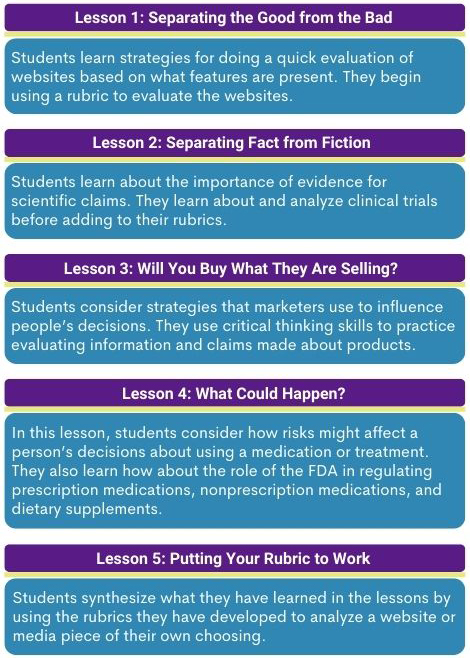
This project was supported by the Office of the Director, National Institutes of Health under award number R25OD020208. The content is solely the responsibility of the authors and does not necessarily represent the official views of the National Institutes of Health.
For a school district, the adoption of instructional materials is a costly investment with long-term impacts. This decision-making process is critically important because instructional materials can either support or inhibit improvements in teaching and learning.
Historically, the selection process can be as simple as an individual leafing through materials—sometimes referred to as a “thumb test”—or as intensive as a year-long process involving teams of teachers and administrators. BSCS Science Learning and its collaborators have designed the NextGen TIME program for districts that are prepared to make an investment in the process to go beyond mere selection of materials to planning for implementation in order to maximize the benefit of their instructional materials.
NextGen TIME is a suite of tools and processes designed for professional development of leaders at the state, district, and school levels. Over the course of the NextGen TIME program, teams of educators are guided through the evaluation, selection, and planning for implementation of materials that will help teachers enact the vision of the Next Generation Science Standards (NGSS) in their classrooms. All program tools are freely available.
This resource was developed in partnership with Achieve K-12 and Alliance at WestEd and was funded by Carnegie Corporation of New York.
